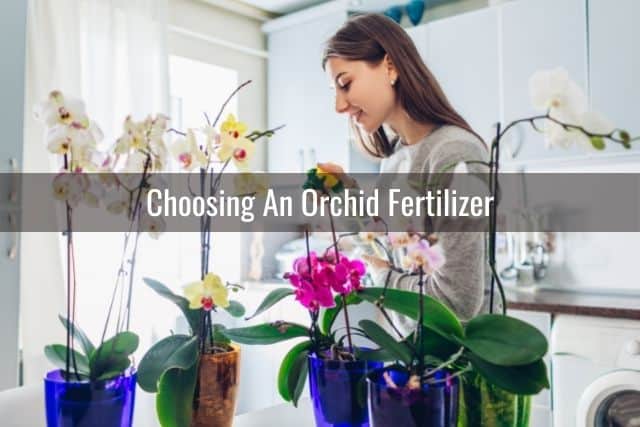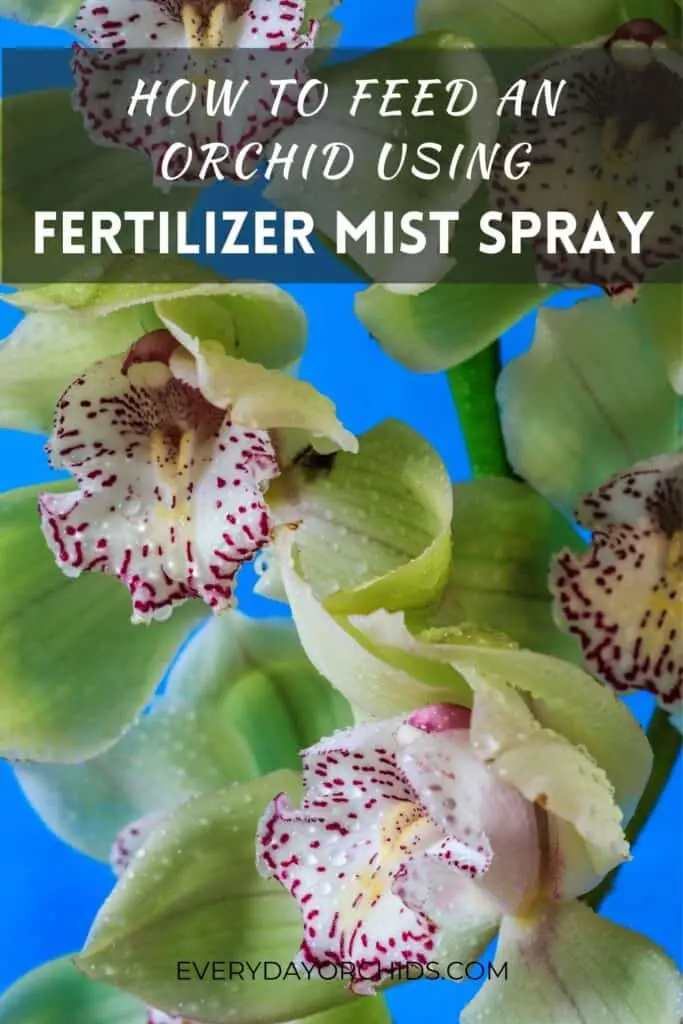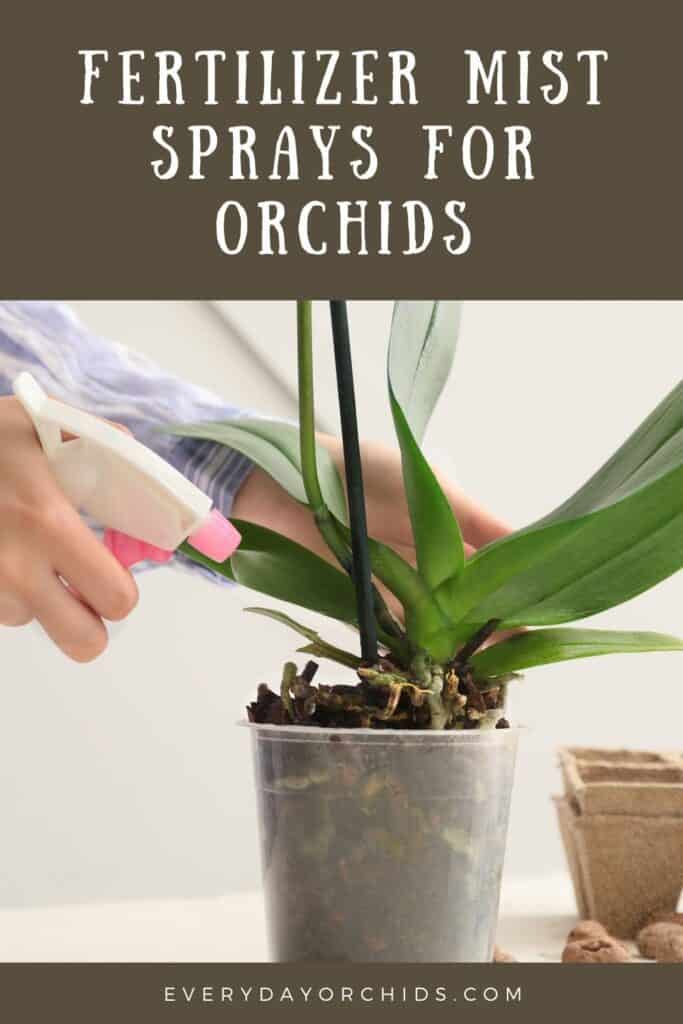Did you know that you can feed your orchids by misting them with orchid fertilizer? This is an alternative to the more common, well-known method of fertilizing orchid roots.
Misting your orchids with a diluted fertilizer is a quick and easy way to feed your orchids. This is also called foliar feeding and is the preferred fertilization method for some orchid growers.

Before you start, keep in mind that misting an orchid is a debated topic amongst orchid growers. As a result, feeding an orchid with a fertilizer mist spray is also controversial.
I’ll go over the pros and cons of feeding your orchids using a mist spray, as well as how to do it. If you do choose to feed your orchid using this method, I’ll also give you some tips that will help you succeed and avoid the risks entailed with misting an orchid. Keep reading to learn more.
Please note that these links are affiliate links and as an Amazon Associate, I earn from qualifying purchases. Purchases made through affiliate links in this post may generate commissions at no additional cost to you. Use this link for a discounted Amazon Prime trial. Thank you for your support!
Table of Contents
How To Apply Orchid Fertilizer As A Mist Spray

Applying orchid fertilizer as a mist spray is also known as foliar feeding. The orchid food is typically misted onto the underside of orchid leaves for best results. The orchid leaves will then absorb the fertilizer.
While many orchid growers might not feed their orchids this way, it is a fairly common way of fertilizing vegetable plants, roses, and other garden plants.
Materials needed:
- Orchid fertilizer of choice (liquid or water-soluble)
- Water for diluting the fertilizer
- Mister bottle for plants
- Prepare the orchid fertilizer according to the package instructions.
- Further dilute the prepared fertilizer with additional water to create a 25% strength fertilizer. To do this, mix one part of prepared orchid fertilizer with three parts of water.
- You will need to do this because orchids prefer weak fertilizer.
- Pour the diluted fertilizer into a spray bottle with a fine-mist nozzle.
- Lightly mist the top and undersides of the orchid leaves and roots with a fine layer of orchid fertilizer mist. Misting the undersides of orchid leaves is key, as the orchid will be able to best absorb fertilizer from here.
- Do not over-saturate the leaves with fertilizer solution. Doing so can cause fertilizer salts to quickly build-up on the orchid leaves. This can be detrimental to the orchid’s health.
Tips For Success
When misting your orchids with a fertilizer mist spray, do this in the morning, once a week. Applying the fertilizer mist in the morning will give enough time for any excess liquid to dry before nightfall.
Once a week feedings will be more than enough for your orchid. During the fall and winter, as the weather gets cooler, you can space the feedings apart to every other week or just once a month.
In addition, make sure you have good air circulation around your orchid at all times. This will help prevent any mold or fungus growth resulting from residual moisture on your orchid leaves. Even a fine misting of the orchid leaves can lead to fungal infections if there isn’t enough airflow around the orchid.
Do not mist the flowers. There isn’t any benefit to misting the flowers with orchid fertilizer. In addition, misting the flowers may lead to fungal infections or unsightly water spots on the petals.
Avoid getting any water into the orchid’s crown. After misting your orchid’s leaves, take care to wipe up any excess liquid that may have ended up in the orchid’s crown. This is important, as this simple step will go a long way in preventing crown rot from occurring.
Water your orchids as you normally would. You will need to water your orchids about once a week. This is in addition to feeding your orchids with an orchid fertilizer.
Choosing An Orchid Fertilizer

If you choose to feed your orchids using a mist spray, it goes without saying that you need to use an orchid-specific fertilizer to do this.
Orchid fertilizers are sold as slow-release pellets, sticks or granules, as a liquid concentration, or as water-soluble granules. Choose an orchid fertilizer that is liquid or water-soluble. This will make it easier to prepare and use.
During an orchid’s active growth phase, feed with a balanced 20-20-20 NPK orchid fertilizer. The growth phase is the period that occurs shortly after the orchid is done flowering and the last bloom has fallen off.
In the fall, as the orchid is preparing for the next blooming season, use an orchid fertilizer that is higher in phosphorus.
The higher phosphorus levels will help support your orchid as it gears up for bloom production. It will allow your orchid to produce more plentiful, healthier blooms during the next blooming season. I would suggest using a 10-30-10 fertilizer, with the higher, middle number representing the phosphorous concentration in the fertilizer.
For more information on choosing an orchid fertilizer, read this guide on how to fertilize your orchid. That guide will walk you through the NPK ratios and the other, more common methods of fertilizing your orchid.
Popular Orchid Fertilizer Mist Sprays
If you aren’t sure where to start, here are some top-rated orchid fertilizer mist sprays available online.
- The Grow Co Organic Ready-To-Spray Orchid Food Mist: This orchid food mist is urea-free and comes pre-mixed in an 8-ounce spray bottle, ready to use. It will likely last you for 6 months or longer, if you feed your orchids just once a week. This is a balanced orchid fertilizer mist spray that works well on all orchid varieties.
- Miracle-Gro Ready-To-Use Orchid Food Mist: This orchid mist spray also comes ready-to-use in a spray bottle equipped with a fine-mist nozzle, perfect for feeding orchids. Keep in mind that the product comes already very diluted, with an NPK of 0.02-0.02-0.02. If you are looking for a stronger fertilizer, or one that is not quite so diluted, you may want to choose something else.
- To learn more, read this guide to Miracle Gro orchid fertilizers.
- Southside Plants Ready-To-Use Orchid Mist: This orchid fertilizer mist spray comes in a 20-10-20 NPK ratio. Like the other mist sprays, it comes already diluted and prepared in a bottle, ready for use. This product can be used on most orchids. However, be aware that the phosphorus levels in this mist fertilizer are low. If you are trying to encourage bloom production, you will need to use an orchid fertilizer with a high phosphorus level (that is the middle number).
Supplemental Orchid Food
I also want to mention Superthrive, which is not exactly an orchid-specific fertilizer, but a vitamin for plants. It is popular in some circles of the orchid community.
Superthrive is a highly-rated supplemental vitamin solution for plants. This product comes concentrated, so you will need to dilute it according to the instructions on the bottle before you use it.
You can use Superthrive as a mist spray (on the leaves) or as a poured solution (on the orchid roots). It can supplement your orchid’s weekly fertilization sessions. It can also be used on your other plants in addition to standard plant fertilizer.
If you do use Superthrive as a supplement to your orchid fertilizer, keep in mind that you will need to dilute the prepared solution further. Orchids like weak feedings, so make a 25% strength Superthrive solution for your orchids.
Benefits Of Using An Orchid Fertilizer Mist Spray

One of the biggest benefits to foliar feeding, or using an orchid fertilizer mist spray, is that it is easy. It doesn’t take any special training to mist a plant. You just grab the spray bottle, do a light misting and you’re done.
If you buy a ready-to-use orchid food mist, then you don’t even have to worry about preparing and diluting an orchid fertilizer. You can just buy the ready-to-use orchid fertilizer in the spray bottle. Use it once a week on your orchids. Doing this takes out the stress and guess-work from feeding your orchids.
Drawbacks To Using An Orchid Fertilizer Mist Spray

While the benefit of using a fertilizer mist spray is the ease and simplicity of use, there are a number of drawbacks you should be aware of. I’ll go over these next.
Build-Up Of Fertilizer Salts
One of the biggest drawbacks of feeding your orchids with a mist spray is that fertilizer salts will build up on the leaves. This build-up occurs over time. It might take weeks before you notice it. Fertilizer salt build-up is unsightly and makes the orchid leaves look very dull.
More importantly, the accumulation of fertilizer salts on the leaves can block the amount of light the leaves receive. Less light means less photosynthesis, which in turn means less energy production and slower growth.
To address this problem, you will need to clean your orchid leaves on a regular basis, at least once or twice a month. Take a soft, damp cloth and wipe down each leaf, top and bottom. Start from the place where the leaf meets the orchid stem and wipe outwards to the tip of the leaf. Support the leaf with your other hand so that it doesn’t bend or split.
When wiping down the orchid leaves, also make sure the cloth is not overly damp. You don’t want to leave residual wet streaks or water on the leaf. Overly wet leaves can end up with fungal infections.
Fertilizer Burn
Misting fertilizer onto orchid leaves can also cause fertilizer burns on the leaves, so watch out for this. One of the key signs of fertilizer burn is the tips of the leaves turn black, or necrotic.
Oftentimes, fertilizer burns on the leaves are a result of over-fertilization. To prevent this from happening, make sure you use a weak orchid fertilizer, meaning dilute your orchid fertilizer down to 25% strength before using it. I went over how to do this above, in the section “how to apply orchid fertilizer as a mist spray.”
In addition, fertilize less frequently during the fall and winter, when orchid growth slows down. During this time, your orchid can get by with once a month fertilization or less. Some orchid species don’t need to be fertilized at all when growth slows down.
Note: If you know what kind of orchid you have, be sure to look up the growing requirements for that particular species. That way, you’ll be aware of its particular fertilization needs.
Fungal Problems
The simple act of fertilizing an orchid doesn’t cause fungal infections. Rather, it is how you do it.
Misting an orchid can raise the chances your orchid will develop a fungal or bacterial infection. Misting orchids is very controversial for this reason.
When you mist your orchid, whether with plain water or with a diluted fertilizer, you are coating your orchid’s leaves and roots with a fine layer of moisture. If you don’t have adequate air circulation around your orchid, this can create an environment perfect for fungal and bacterial growth. Same if you mist your orchids in a high humidity setting without adequate airflow.
Wet orchid leaves plus poor air circulation and/or high humidity will lead to fungal issues in your orchid. Namely, your orchid can develop rot, brown spot, crown rot, and other problems. This can happen even if you don’t mist your orchids, but misting can certainly cause problems to appear much faster.
To minimize the risk for fungal problems, make sure you have good air circulation around your orchid pots. Follow the “tips for success” I outlined above, including misting your orchids in the morning and wiping away excess water from the orchid’s crown.
Can You Mist Other Plants With Leftover Orchid Fertilizer?
Yes and no. Yes, you can mist your other plants with leftover orchid fertilizer, but don’t expect it to meet your other plants’ fertilization needs. Remember, orchids prefer weak fertilizer. This means you are probably using a 25% strength orchid fertilizer to feed your orchids. While this is perfect for your orchids, it is too diluted for other plants.
In addition, orchid-specific fertilizer is, as you would guess, tailor-made for orchid use. While it will provide some nutrition for your other plants, orchid fertilizer won’t match the NPK needs of your other plants.
Houseplants, for example, need less phosphorus than orchids, since many houseplants do not produce flowers. Other plants may need more nitrogen than what is available in orchid fertilizers. Calcium and magnesium are not typically found in orchid fertilizers, yet many vegetable plants require these to grow and fend off disease.
All that said, if you have extra, leftover orchid fertilizer and don’t want to just pour it down the drain, then yes, use the rest up on your other plants. They will get a light feeding from this. However, you will still need to use a standard fertilizer on your houseplants, roses, or vegetable garden, simply because they will need more nutrients than what a diluted orchid fertilizer can provide.
Final Thoughts
Misting your orchids with a fertilizer solution is a fast and simple way to feed your orchids. You can do this each week when you water your orchids. However, just as misting an orchid is controversial, feeding orchids with a mist spray is also controversial due to the many risks involved.
If you choose to feed your orchids with a mist spray, go into it knowing the risks. Learn how you can prevent fungal problems and other issues from occurring. At the very least, make sure you have good air circulation around your orchids and manage your humidity levels around the orchid growing area.
Many orchid growers have used an orchid fertilizer mist spray with great success, while others haven’t noticed much of a difference. Keep in mind that it may take a few weeks of misting with an orchid fertilizer spray before you see any notable difference in your orchid’s growth and appearance.
If you enjoyed this article, please pin it and share!





